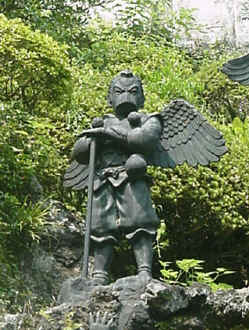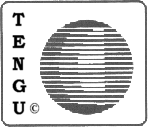|
What is a Tengu ? Several Sempai practicing regularly in Strasbourg with Sensei Habersetzer had not failed to notice that something new had been going on for some time in his CRB ( Budo Research Center ), something called... "Tengu". Some of them finally asked him what it was all about, to understand what was on their Sensei’s mind, who had developed this new concept and integrated it in his martial processes. Indeed, since 1995, he had been directing the Tengu Institute he created, and has started to mention it publicly or on the occasion of recent publications, such as his book "Tonfa" or his reflection untitled "Empty hand for a martial edge". |
Karasu Tengu |
|
The CRB experts, who participate in the ceaseless work of research in the martial domain – the Sensei’s passion ever since the day he first set foot on a tatami...40 years ago – but also several careful Sempai, are perfectly aware of the enlargement of a process that must give back Karate, according to the president of the CRB, its true ancient martial meaning, in retrieving sensations, and a raison d’être, lost long ago because of the competitive evolution of Karate. May the others read the unsettling text "Karate: empty hand for a martial edge. Reflections for a return to a warlike dimension in the traditional art of Karatedo", published by the Tengu Institute, that broadly introduces the subject. The last two sessions of the Instructors School ( Ecole des Cadres ) also clarified this direction for Karate inside the CRB: the Tengu Institute is a setting for advanced practice in the field of the art of fighting, along two axes: building and managing a retaliation force ( with a global dimension and the complementarity of integrated defense techniques, as true weapon ), always perfectly controlled by the "right spirit". This IS the DO, the ethics for any determined and responsible man or woman of his/her time, in THE RESPECT OF THE PRICIPLES OF A TRUE MARTIAL ART, RECONSIDERED FROM A CONTEMPORARY ANGLE, THEREFORE EVOLUTIVE. A big work at hand. As such, the Tengu Institute is a real laboratory for research and experiments that extends the teaching given in the CRB dojos, sharpening it, never denying any part of it. All this makes it probably a practice setting unique in the world. Beyond the technique, there is above all a "Tengu Way" that consists in knowing ( using physical and mental advantages ) how to RESPOND, like a human being, to a threat, instead of REACTING, like a fighting animal. A fundamental subtlety. So why "Tengu" ? What is a "Tengu" ? Read its definition by Sensei Habersetzer and you will certainly better understand this meaningful choice. As we later give an explanation for the symbol designed by Roland Habersetzer to stand for his idea, we shall underline more clearly the orientation of the "Tengu Way" ( Tengu-no-Michi ) as he wishes to share it with greatest number of sincere and realistic budokas. Way beyond an elementary Bunkai, of course. But, coming from him, did you even have any doubt ? |
|

